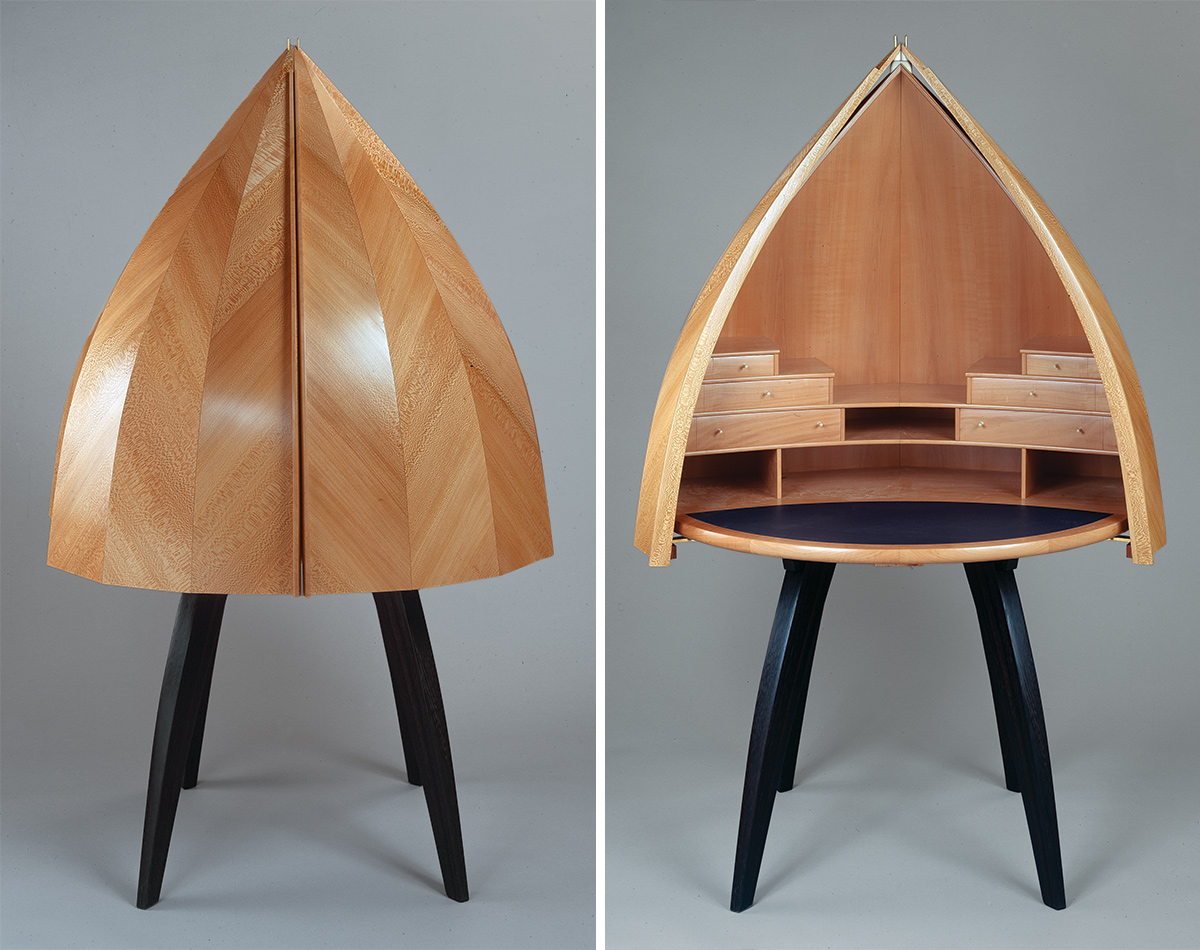Remembering Jere Osgood, a quiet innovator who bent wood to his will
Looking back at the furniture and philosophy of Jere Osgood, who died Oct. 10, 2023.
Synopsis: Looking back at the furniture and philosophy of Jere Osgood, who died Oct. 10, 2023. His chairs, chests, and desks pushed well past the boundaries of traditional forms and building methods, while remaining firmly rooted in function, ergonomics, and sound structure.
When Jere Osgood died October 10, we lost one of the great furniture makers of the past half century. Equally gifted as a designer and as a craftsman, Osgood was a relentless innovator, developing furniture forms we’d never seen and construction methods we’d never dreamed of. His chairs, chests, and desks pushed well past the boundaries of traditional forms and building methods, yet the work remained firmly rooted in function, ergonomics, and sound structure.
Born in 1936 and raised on Staten Island in New York City, Osgood worked in his father’s basement shop as a boy and started a furniture business there before he was in his teens. By the time he made his way to the School for American Craftsmen at Rochester Institute of Technology (RIT) at age 22, he had been selling furniture for a decade and his work was in galleries in New York City.
Despite being painfully shy, Osgood began teaching not too long after leaving RIT; he taught part time at the Craft Students League, in Manhattan, then full-time at RIT, and eventually, from the mid-1970s to the mid-80s, at Boston University’s Program in Artisanry. At BU he and co-teacher Alphonse Mattia presided over a great flowering of young furniture makers. Among the extraordinary students there were Michael Hurwitz, Tom Hucker, Wendy Maruyama, James Schriber, Garrett Hack, Tim Philbrick, and David Lamb. Osgood was a tight-lipped teacher (Hurwitz estimates that he could be counted on for about one sentence of instruction per week), but he had a deep impact on his students through the power of his work and his dedication to it.

To illuminate some of Osgood’s thinking about his work, we’ve gathered here quotes from a range of interviews this quiet craftsman gave over the years.
Education
When Osgood arrived at RIT in the late ’50s, his teacher Tage Frid was aghast to find that Osgood, who was self taught to that point, had developed his own methods of joinery, and Frid told his student he had to unlearn everything he knew. Osgood might have been shy, but he was unmoved. Years later, referring to Frid, he said, “People will say ‘Design around the available techniques,’ but I don’t think that’s right. If you have something important to say in your design work, you have an obligation to find some way to make it. I don’t spend all my time inventing new techniques, but I have perfected a few.”
In the 1960s, Osgood began exploring ways to build case pieces by using what he called compound stave lamination—a cross between bent lamination and coopering. Once he developed the technique, he spent five decades perfecting it in a range of chests and desks. “I had always felt that there was a terrible waste of wood in traditional bombé chests; they get their curves by removing pounds and pounds of wood. And at RIT I was exposed to shaped and carved forms laminated up with heavy stock and then formed into curves with a body grinder and so forth. I didn’t want any part of that, because I felt the aesthetic was too foreign to the material.”

Wendell Castle, who taught at RIT and worked just outside Rochester, had a powerful impact on the field. In the 1960s and ’70s his monolithic stack-laminated pieces influenced many other makers. But not Osgood. “I was at the opposite end of the design spectrum. While many woodworkers were making their furniture heavier, mine grew increasingly lighter. I placed more emphasis on pre-planning than on shaping. The forms in my work come from bending the wood into a light shell instead of removing stock. I’d rather spend my time drawing and making jigs than chopping away at lumber.”

Osgood had spent three years studying architecture at the University of Illinois before attending RIT, and the drafting skills he acquired at Illinois became integral to his furniture designing process. “The drawings for my big pieces are killers. A desk could be the result of 35 or 40 different drawings—sections and rotated sections and top views superimposed over side views. It’s just a mess; I don’t like to hurt my brain that much. But I couldn’t do without them.”
On design
Osgood’s shell desks stand among the most aesthetically expressive and technically impressive American pieces made in the 20th century. About them, he said, “I’ve felt freer with the desk form than the chest of drawers, which is a more definite mass; the chest is a solid form, whereas the desk can have open areas to balance the solid ones. The desk is a haven for sculptural forms.” One aspect of designing his shell desks presented an ongoing puzzle. “I realized early on there were two separate compositions: the desk when it was closed, and the desk when it was opened. I spent a long time working on the insides as a definite form in itself. Maybe some of the interiors I’ve done are too separate. You know, when you cut a seed pod open there’s a structure inside there that is itself but is very much in harmony with the outside form of the pod. So I think I have some studying to do there.”
Osgood worked long hours in his New Hampshire shop, but he typically took a walk in the woods each day. “It’s important to me to get out in nature where things are in a formative stage. In a museum everything you see is completed, whereas in the woods it’s an ongoing, living process.”
“Somewhere way back there I got dissatisfied with square furniture forms. In nature—with the flow of water, the movement of air, the growth of trees—there aren’t any right angles; there aren’t many flat planes. You get all these compound-curved forms all the time in the natural world, and I related those to furniture.”
Natural forms were an inspiration for Osgood, but he never relied on them as a precise template, any more than he employed specific geometric shapes. “After taking math courses in college, I started plotting parabolic curves for the bowls and plates I was making. But somewhere along the way I realized I’d get better and more sensitive work if I didn’t do that; that I needed to rely on my personal, irrational eye rather than a mathematical form. You get these little idiosyncrasies in your curves if you draw them by hand.”
One event that helped shape Osgood’s development as a designer occurred quite early. “When I was 19 or 20 I ran into Wharton Esherick’s work in New York City. What he did was make me see that it was all right to design things in your own way. I wanted the freedom I saw in Esherick’s work, and I didn’t want the restrictions I saw in commercial furniture.”
Osgood’s pieces could seem like expressions of pure form. Asked once if he had ever been tempted to abandon utility and ergonomics in his work and pursue sculpture, he said, “I’d have to totally change my position on this planet, because I do want furniture to be functional. I’m always checking heights and clearances, depths and so forth related to using it. So, in this lifetime I might not get to that.”

Osgood was the apotheosis of the designer/maker: equally talented and committed as a designer and as a craftsman. “The process of making a piece is terribly important to me; it’s the designing but also the actual making in the shop that I’m so much involved with. And that’s not something that goes along with the finished piece. The customer can’t buy the experience of creating that piece, and I can’t give it to them.”
By 2004, Osgood had been working wood for six decades. But he hadn’t slowed down. “I’d like to think I keep learning,” he said then. “I’ve got a better understanding of the forms I’m working with than I did 25 years ago, or even 10 years ago. So, there’ll be a race against biological time to see how the next 10 or 20 years will go. But I like to think that I’m getting better.”
A lasting legacy
Tom Hucker studied with Osgood at the Program in Artisanry, where Hucker was, by his own description, “a shy, skinny kid in the corner.” Hucker has gone on to become one of the most accomplished furniture makers of his generation. Of his former teacher, he says, “I look at Jere as the John Coltrane of woodworking; Coltrane altered the compositional approach to music, and to me, that’s Jere. He is so good at what he does that he can afford to improvise.”
One of Osgood’s students at RIT was Richard Newman, a maker renowned for the stratospheric level of his craftsmanship. In 1968, when he saw a mahogany chest of drawers Osgood had made using his compound-stave lamination technique, Newman says, “I was stunned. It was the most sophisticated piece of furniture I’d ever seen in my life.” Seeing that chest convinced Newman to return to RIT for a year to study with Osgood. “Jere spoke very eloquently about his work,” Newman said. “I remember wanting him to say a little more, but it wasn’t his way. He had this lovely modesty about him, yet he was confident and bold as a craftsman.”
For more on Osgood, see his articles “Tapered Lamination”, FWW #14, and “Bending Compound Curves” FWW #17, and Jonathan Binzen’s profile, “The Best Woodworker You’ve Never Heard Of,” FWW #225.
Photos, except where noted: courtesy of Jere Osgood
From Fine Woodworking #308
Fine Woodworking Recommended Products

Drafting Tools

Stanley Powerlock 16-ft. tape measure

Blackwing Pencils

























Comments
Great profile. Thank you.
Log in or create an account to post a comment.
Sign up Log in